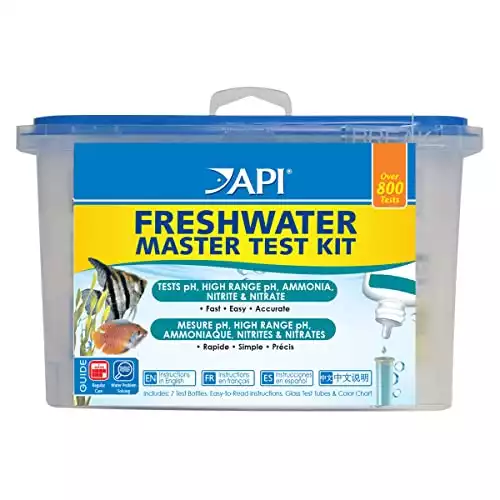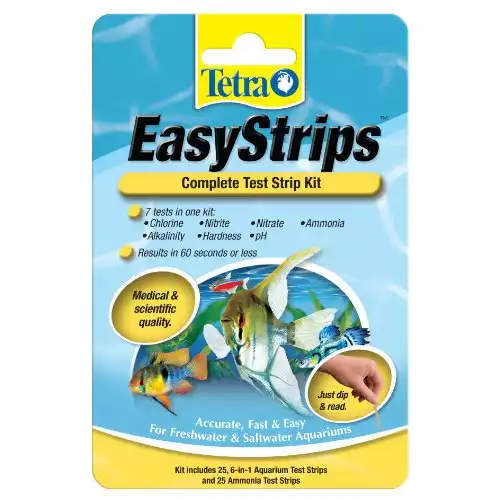
Why Are My Fish On The Bottom Of The Tank?
Fish laying on bottom of tank breathing slowly or gasping? If you find this is happening in your aquarium, you need to figure out if there is an issue that needs fixing or if it’s normal behavior for the fish.
I’ll go over the most common reasons why fish sit at the bottom of the tank and go through how you can treat your fish (if necessary).
The most important thing to know is, what is classed as normal behavior for your fish and what is unusual behavior.
If your fish usually hangs out in the top half of the tank then all of a sudden it is laid at the bottom breathing heavily or gasping for air, you know you have an issue on your hands.
If every evening when your aquarium lights switch off, your fish lays on the bottom of the tank breathing slowly, you know it’s just getting some rest and there’s no need to worry.
Is It Normal For Fish To Sit At The Bottom Of The Tank?
The answer is, it depends! There are many ‘normal’ reasons why your fish is hanging out at the bottom of the tank, without any cause for concern.
Here are the most common ‘normal’ reasons:
1. Bottom Dwelling Fish

If your fish is a bottom dweller, they are naturally inclined to hang out in the bottom 1/3 of the tank.
These fish love to scour the substrate looking for any bits of food and algae they can feast on.
Some fish like the kuhli loach will completely bury themselves in a fine sand substrate, they are known to ‘disappear’ and then pop back up days later to feed.
In general bottom dwelling fish have their mouths positioned at the bottom or underneath their head, so this can help you establish if they are a bottom dweller or not.

Some common bottom-dwelling fish are:
- Apistogramma cichlids
- Bristlenose pleco
- Bumblebee goby
- Clown loach
- Corydoras
- Kuhli loach
- Geophagus
- Otocinclus
- Reticulated hillstream loach
- Shrimp
- Siamese algae eater
- Twig catfish
So, if you notice your fish are staying at the bottom of the tank and they are a bottom dweller and breathing normally, you can relax and there’s no need to worry.
2. Fish Sleeping At Bottom Of Tank
If you notice your fish goes to the bottom of the tank at a similar time each day, it will be going to sleep or rest.
Some fish are active through the day and sleep at night (diurnal), and some fish are active at night and sleep through the day (nocturnal).
Because fish don’t have eyelids, it is difficult to tell if they are asleep, they will be laying fairly motionless and breathing slowly when sleeping.
It’s important to switch your aquarium lights off at night to allow your fish to rest properly, I use a timer switch so I don’t forget. 8-10 hours of light per day is ideal for most fish.
3. New Fish Sitting At Bottom Of Tank
New fish can be skittish and hide when added to a new aquarium, so they often retreat to the bottom of the tank where there are more places to hide amongst plants and decorations.
Once they feel safe, they will start exploring their new home.
Adding some dither fish is also a great way to help coax out shy fish.
4. Old Fish At Bottom Of Tank
Like humans, the older fish become the more rest they need.
Unless you bred the fish yourself it can be difficult to know their exact age.
Different types of fish have different lifespans. Betta fish and goldfish for example can have very different life expectancies, bettas tend to live for 3-5 years, whereas goldfish can easily live for 10 years or more.
What is classed as old age for one type of fish can be young or middle-aged for another.
5. Resting Fish
Fish that rest the most generally have more elaborate fancy fins, like betta fish and fancy goldfish.
Because they don’t have streamlined bodies, it takes a lot of hard work and effort for them to swim. I imagine it’s like trying to swim in a wedding dress!
You can buy specific ‘betta leaf hammocks’ that suction cup onto the side of your tank, so your betta can get some well-deserved rest, alternatively live plants with broad leaves are great for bettas, just be sure you don’t add any toxic plants.
If you find your fish laying at bottom of tank still breathing, chances are it’s probably just catching up on some sleep or chilling out, if it’s gasping or breathing fast you may have an issue on your hands.
Concerning Reasons Why Fish Lay At Bottom Of Tank
Here are the most concerning reasons why your fish is laying at the bottom of the tank and how you can treat the problem.
6. Ammonia, Nitrite, or Nitrate Poisoning
Keeping the aquarium nitrogen cycle in check is an essential part of keeping fish healthy.
Ammonia and nitrite poisoning is a death sentence for fish if not treated. Although nitrate isn’t as deadly, you still need to keep it within safe levels.
- Ammonia levels should be 0ppm.
- Nitrite levels should be 0ppm
- Nitrate levels should be kept below 20-40ppm (depending on the type of fish)
If you notice any of your fish are behaving unusually or appear unwell, the first thing to do is check the water parameters using a water testing kit or test strips.
4.7 | 4.5 |
The API freshwater test kit offers outstanding value (over 800 tests!) and is very accurate, if you're serious about fishkeeping this is the best test kit to buy and the only one I use. | The Tetra test strips are quick & easy to use and measure all the vital water parameters that you need to monitor to keep your fish safe, but it can be difficult to read the colors, making them less accurate than the API water test kit. |
$13.49 | |
The API freshwater test kit offers outstanding value (over 800 tests!) and is very accurate, if you're serious about fishkeeping this is the best test kit to buy and the only one I use.
The Tetra test strips are quick & easy to use and measure all the vital water parameters that you need to monitor to keep your fish safe, but it can be difficult to read the colors, making them less accurate than the API water test kit.
Some symptoms of poisoning in a fish tank are:
- Redness on gills, fins and/or body
- Labored breathing
- Clamped fins
- Lethargic
- Loss of appetite
- Fish hanging out at bottom of tank (near filter output where there’s more oxygen)
- Fish gasping at the surface
- Fish rubbing itself against substrate, decor, or rocks (also known as flashing)
Some of the most common causes of raised ammonia, nitrite, and nitrate levels in a fish tank are:
- Not cycling the fish tank before adding fish
- Poor tank maintenance
- Overstocking fish tank
- Overfeeding fish
Seachem Prime is an essential item for ALL fishkeepers!
It removes chlorine and chloramine from tap water.
It detoxifies ammonia, nitrite & nitrate, making the aquarium water safe for your fish.
Directions: Add 5 ml per 50 gallons (200 liters) for regular detoxification.
Up to 5 times the dose (25 ml per 50 gallons) can be used in an emergency if ammonia or nitrites exceed 2 ppm.
- Easy to use
- Removes chlorine & chloramine
- Detoxifies ammonia, nitrite & nitrate
- Doesn't expire (if stored correctly)
- Suitable for fresh & saltwater aquariums
- Strong sulphur smell
If your ammonia, nitrite, or nitrate levels are high, perform a partial water change (up to 50%) and then add a treatment to the water such as Seachem Prime.
7. Other Types Of Poisoning
Have you recently set off a bug bomb in your home? Sprayed other chemicals near your fish tank? If you answered yes to this, you may have accidentally poisoned your fish.
I suggest cleaning your tank and performing a water change as soon as possible.
8. Incompatible Tank Mates
Is your fish being bullied by one of its tank mates? Not all types of fish get along with each other.
Check out this compatibility chart, to see if your fish can be housed together.
If a fish is being bullied it may retreat to the bottom of the tank to hide or stay in one spot where it feels safe, if it appears to be breathing heavily or gasping (rather than slowly when resting or sleeping), it is a sign your fish is stressed.
Keep an eye out for any fish harassing each other, sometimes it’s just the dominant fish asserting its authority and putting another fish in its place, which should resolve itself.
If it doesn’t resolve itself, you’ll need to rehome one of the fish.
9. pH Level Swings

pH levels should be kept as stable and consistent as possible, large swings up or down (of more than 0.3 within 24 hours) will stress your fish, leaving them vulnerable to illnesses and disease, which could cause them to lay on the bottom of the tank.
Most fish can adapt and happily live in a pH level around 6.5-8.0, there are a few exceptions to the rule, such as African cichlids which prefer the pH to be 8.0+, and South American cichlids prefer a pH of around 6.0.
If you need to lower your aquarium’s pH level or raise it, it’s advised you do it slowly using natural methods, so that you don’t stress your fish.
10. Tank Too Small
Having a tank that is too small or overcrowded is a surefire way to have unhappy, unhealthy fish.
In a small tank, it is more difficult to keep water parameters safe and consistent, meaning you are much more likely to have ammonia spikes, pH swings, temperature fluctuations, etc.
Having a small tank with too many fish in it can lead to territorial issues and fish harassing and fighting each other as there isn’t enough room for each fish to have its own space.
Upgrade to a larger tank or rehome some fish to solve the issue.
11. Water Temperature

You should aim to keep your water temperature consistent. Sudden temperature changes will stress your fish.
Different types of fish prefer different water temperatures, for example, betta fish are tropical fish, so they require the water to be heated to around 78°-82° F / 25.5°-27.5°C, and goldfish prefer cooler water of around 65°-72° F / 18°C-22°C.
Cold water retains more dissolved oxygen than warm water does.
Fish breathe dissolved oxygen from the water but if the water is too cold their metabolism will slow down. If this happens they may lay motionless at the bottom of the tank to conserve energy.
If the water is too hot, there isn’t as much dissolved oxygen in the water.
The water at the bottom of the tank will be cooler (we all know heat rises) and therefore have more dissolved oxygen than the water at the top of the tank.
If you’ve got a fish, or fishes, laying at the bottom of the tank with labored breathing, or appearing lethargic, check the temperature of the water.
Warmer water can also cause your fish’s metabolism to increase which can lead to overeating.
More food going in will mean more poop coming out. More poop means ammonia which will deplete the water’s oxygen levels.
To keep the water temperature consistent use a high-quality water heater and digital thermometer to check the water temperature.
Diseases That Can Cause Fish To Lay On Bottom Of Tank
There are a couple of diseases that could be causing your fish to sit on the tank bottom.
12. Ich

Ich, also known as white spot disease or ick, can be difficult to treat as it spreads quickly.
It’s a parasitic infection that takes advantage of your fish when their immune system is suppressed.
Symptoms of ich include:
- Increased respiratory effort
- White spots on the body, fins, and gills
- Flashing – flattening themselves out at the bottom of the tank and rubbing against the substrate or decor
- Bruising or scale loss – this will be a sign that your fish has been flashing
- Loss of appetite
- Appearing lethargic
- Hiding more than normal
- Fins clamped to the body
- Pale coloration
Causes of ich include:
The No.1 cause of why fish get ich is not quarantining new fish, invertebrates, or plants before adding them to your display tank.
Other causes include:
- Poor tank maintenance
- Overstocking
- Being bullied by tank mates
If you suspect you have an ich outbreak in your aquarium, I’ve done an in-depth post on how to treat, prevent, and get rid of Ich on Fish.
13. Swim Bladder Disease

Swim bladder disease is not actually a disease per se, it’s a disorder where your fish’s swim bladder does not function correctly.
If your fish is floating at the surface and is unable to swim down to the bottom of the tank, that is called positive buoyancy disorder.
Negative buoyancy disorder has the opposite effect and your fish appear to be stuck at the bottom of the tank, unable to get to the surface.
Signs of swim bladder disease include:
- Ulcerations and infections to the skin (caused by rubbing against the sand or substrate)
- A swollen belly
- Being unable to swim upright – often on their side with their tail higher than their head
- Bobbing back and forth
- Floating upside down (this is typical for Fancy Goldfish right after feeding)
- Trying hard to swim but not moving
Causes of swim bladder disease include:
- Poor aquarium water quality
- Compression from tumors, cysts on the kidneys, or fatty deposits on the liver
- Constipation
- Defect at birth
- Deformation of the spine
- Egg binding if your fish is female
- Overfeeding
- Physical injury trauma
- Stress due to poor water quality
- Water temperature is too low
If you think your fish may be suffering from negative or positive buoyancy disorder, there are various treatment options you can try.
FAQ
Here are some frequently asked questions about fish laying on the bottom of the tank.
If you suspect there is an issue, the first port of call is to check your water parameters are good, as that is usually the main reason why fish are acting strange or become ill.
Why Is My Fish Laying At The Bottom Of The Tank But Still Breathing?
If your fish is laying at bottom of tank still breathing, it’s probably just having a rest or catching up on some sleep.
If it’s breathing heavily there’s either not enough oxygen in the water, or your fish may have an illness such as ich.
Fish Laying On Bottom Of Tank Gasping
Test that the water temperature isn’t too high (warmer water contains less dissolved oxygen than cooler water) and test the water parameters.
If those tests are okay your fish may have an illness, go through my concerning reasons why fish lay at bottom of aquarium and eliminate them one by one until you find the issue.
Betta Fish Laying On The Bottom Of The Tank
Betta fish use a lot of energy swimming around due to those beautiful long-flowing fins not being very streamlined, so it’s probably just having a rest.
As always if you suspect something isn’t right, check your water parameters.
Goldfish Laying On The Bottom Of The Tank
Goldfish, particularly fancy goldfish, are known for having buoyancy issues due to their squashed weirdly shaped bodies!
This tends to happen right after eating, they sometimes even flip upside down, it should sort itself out within a couple of hours.
However, If it doesn’t correct itself, check if the water parameters are ok.
Closing Thoughts On Why Is My Fish Laying On Bottom Of Tank?
Hopefully, you will now know if the reason your fish is staying at the bottom of the tank is anything to worry about or if they are just catching 40 winks.
For more guides on keeping your tank in tip-top shape, check out the aquarium health section.



